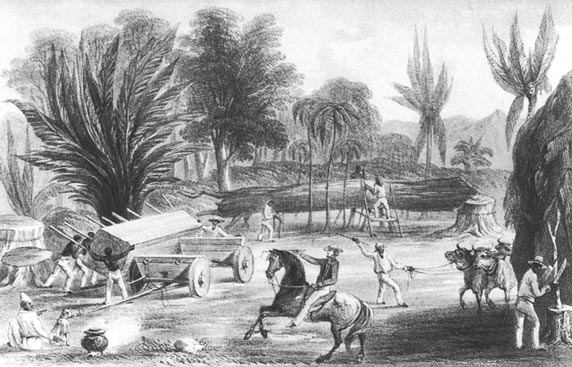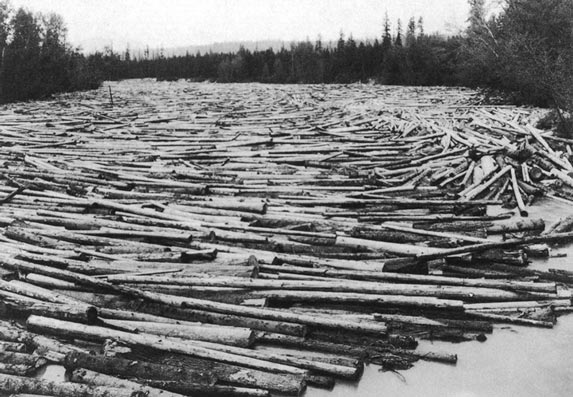
This Article From Issue
September-October 2003
Volume 91, Number 5
DOI: 10.1511/2003.32.0
Deforesting the Earth: From Prehistory to Global Crisis. Michael Williams. xxvi + 689 pp. University of Chicago Press, 2003. $70.
In an epic undertaking, Michael Williams has provided a seven-millennium overview of the impact human beings have had on "their incomparable heritage, a green, global mantle of forest." Any caveats aside, Deforesting the Earth is a remarkable scholarly achievement, replete with 159 pages of notes and bibliography. The text is also well supported by dozens of tables and figures.
For those who are interested in environmental history or history itself, and those whose lives are touched by some aspect of global deforestation, this volume provides the valuable perspective of historical geography. (Williams is a professor of geography at the University of Oxford.) The story told here of the cutting down of trees is "as old as the human occupation of the earth." It is also a global tale; the inclusion of China and Japan, particularly from the 16th century onward, is excellent and important, even though not much historical detail about the clearing of forests in those countries is available.
This is the story of human activities that affect the forest—primarily the clearing of land for agriculture and the harvesting of trees for use as fuel, lumber for constructing buildings, and other products. For most of history the use of timber for shipbuilding was also important, so vital that in 1611 Arthur Standish observed, "No wood, no Kingdome." Deforestation has thus been seriously driven by trade. Indeed, for the nonhistorian it is a revelation to recognize just how dominant trade and commerce have been in the human equation since earliest times.
Williams portrays clearly and in some detail the human drama leading to the retreat of forests. For example, in the case of British shipbuilding for military and commercial purposes, he describes an intricate interplay between Baltic and North American sources of timber and naval stores (pitch, tar) before and during the Napoleonic era. Maintenance of the British shipbuilding industry also lent an imperative to the British role in India, because of the need to control supplies of teak from Malabar. Only the advent of iron ships put an end to this major use of forests.
The sheer volume of wood taken for various purposes is documented impressively, whether for construction in growing cities in all parts of the world, for fuel (in 1815, Parisians used 1.8 cubic meters per capita, and Muscovites burned many times that quantity), or for railroads (U.S. railroads used one-fifth to one-fourth of annual U.S. timber production in the latter part of the 19th century).

From Deforesting the Earth.
Surprisingly, consumption of wood as a commodity played only a secondary role. In the end, clearing for agriculture is the single greatest cause for deforestation past, present and presumably future. In this connection, it would have been helpful if Williams had probed the extent to which the intensified agriculture of the Green Revolution and the urban implosion may have taken some pressure off forests. He does demonstrate that the role of agriculture in deforestation is complex—as has been revealed by, for example, the interplay among landless people, large-scale agriculture and land speculators in the Brazilian Amazon.
In other ways Williams's discussion is rich and revealing, particularly in his account of North America. From the early colonial impression of a glut of "vegetable wealth" to the advent of commercial logging in the early 19th century, the story seems to be one of a perception of an inexhaustible resource. Why else would it be that in Britain, by 1810 all of the furnaces for smelting iron were being fired by coal rather than wood, whereas in the United States, the use of coal for that purpose began only in 1835, and wood-stoked furnaces continued to operate until 1945? The British artist and writer Basil Hall in the 1820s described fields with "numerous ugly stumps of old trees; others allowed to lie in the grass guarded, as it were, by a set of gigantic black monsters, the girdled, scorched and withered remains of the ancient woods"—a description that calls to mind 21st-century photographs of tropical deforestation. By 1900, half of the original forest cover in the United States had been eliminated, and logging peaked in 1906 at 46 billion board feet.
Thrice in this long saga of sylvan destruction there was a major resurgence of forest: In medieval Europe, trees readvanced on the fields after millions died of bubonic plague or were killed during the Hussite Wars and the Hundred Years War. In North America, after the indigenous population had been decimated by diseases brought by Europeans, by 1750 the forest was "probably thicker and more extensive than . . . at any time for the previous thousand years." And in eastern North America, after much of the population went into industry or headed westward in search of better agricultural land, forests underwent another remarkable recovery.
From very early times, there was a recurring, if faint, concern about the consequences of deforestation. Christopher Columbus asserted that destruction of forests in the Atlantic islands (Madeira, Canaries, Azores) had reduced rain and mist. Not until the early 1980s was this relationship between forests and hydrology definitively demonstrated: Eneas Salati and colleagues showed that the forested Amazon generates about half the rainfall in the region. (Williams asserts that the effects of deforestation on rainfall are uncertain. I disagree; however, it is true that a detailed understanding of the hydrological cycle remains to be achieved.)
A century or so after Columbus voiced his worries, people in Venice became concerned over siltation of the Venetian lagoon deriving from deforestation. In 1662 in Britain, John Evelyn pleaded before the Royal Society for more rational use of all land, forested or not (a discourse the Society published two years later under the title Sylva). The French Forest Ordinance in 1669 attempted to rationalize and codify forest law in that country, and by the beginning of the 18th century, the German tradition of forest science and regulation had begun. Yet the problem of how to stop the destruction of forests in Europe "defied solution," and many of the proposals for stopping it excluded the poor from access to resources that were critical for them (a recurring theme in the history of forests). Far more successful, and indeed remarkable and exceptional, was the Japanese system of regulation and remediation, which probably worked because of Japan's close-to-total isolation from the rest of the world.

From Deforesting the Earth
In America, awareness and concern came later. Deforestation was massive, but forests were nonetheless still vast. George Perkins Marsh's Man and Nature: Or, Physical Geography As Modified by Human Action, published in 1864, marked the beginning of change. The book later resonated with figures such as Gifford Pinchot, who had trained in the German forestry tradition, and Theodore Roosevelt. In the 1890s various pieces of federal legislation were passed, and in 1898 Pinchot became head of the U.S. Division of Forestry. The first schools of forestry in the United States were established around the turn of the century. Curiously, although Williams does not mention the fact, areas were designated as protected before this (Yellowstone as the world's first national park in 1872; Yosemite as a public trust in 1864). But those designations were motivated by scenic and aesthetic concerns, whereas the protection and management of forests was predominantly a resource issue.
The final fifth of Deforesting the Earth is devoted to the past 50 years, "The Great Onslaught," the period during which net deforestation in the temperate developed world has been close to zero while a huge area in the tropics—555 million hectares—has been denuded of trees. The events described are, for some, familiar, but troubling. They are well summarized here.
The book loses some focus, however, in covering the past two decades and the rise of concern about biodiversity and climate change. It is probably unfair to be highly critical. This is, after all, a volume about historical geography, not an environmental tome, and it is hard to treat what is essentially a contemporary problem as history. For example, Williams makes quite a to-do about inconsistencies in data collected by the United Nations Food and Agriculture Organization, which stem from the data's dependence on national reports and a lack of comparability in methodology from year to year. But this is no longer an issue: That system has been superseded by the greater precision available from satellite imagery. Regrettably, the discussion of biodiversity is a bit confusing. Although the book makes apparent the central importance of forests, especially tropical forests, to concerns over the loss of biodiversity, it inexplicably mutes the fact that we are clearly in the first stages of the sixth great extinction.
In a work of such scope, small errors are almost inevitable. So one could quibble, for example, that agricultural workers in Rondônia in the 1970s could not have been "inoculated against malaria," because no vaccine existed, and one could wonder whether paper and pulp deserve more mention. But to focus on such points would be petty in the face of a signal scholarly achievement.
This is a breathtaking work in the sweep of what it encompasses. It is also a book important for many interests: environmental, historical, economic and more. Clearly it will endure for decades to come, even after the current struggle over remaining forests has largely played out.
American Scientist Comments and Discussion
To discuss our articles or comment on them, please share them and tag American Scientist on social media platforms. Here are links to our profiles on Twitter, Facebook, and LinkedIn.
If we re-share your post, we will moderate comments/discussion following our comments policy.